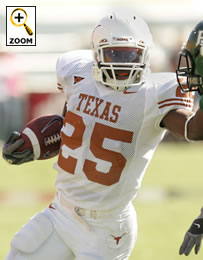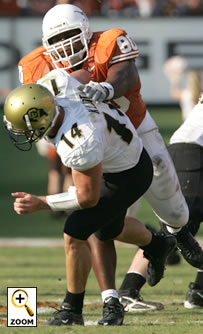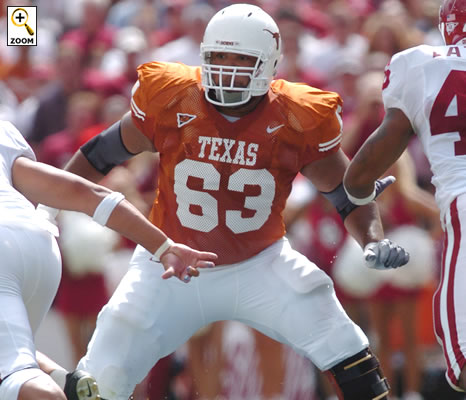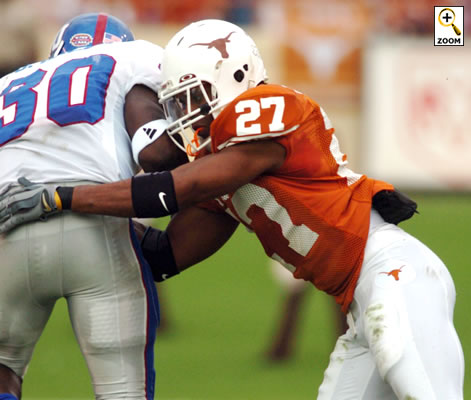 |
| RB
Jamaal Charles (PHOTO CREDIT: Jim Sigmon/Univ.
Of Texas) |
|
| |
| 2005
Statistics |
Coach:
Mack Brown
83-19,
8 years |
| 2005
Record: 13-0
National Champions |
|
| LOUIS-LAFAYETTE |
WON
60-3 |
| at
Ohio State |
WON
25-22 |
| RICE |
WON
51-10 |
| at
Missouri |
WON
51-20 |
| vs.
Oklahoma |
WON
45-12 |
| COLORADO |
WON
42-17 |
| TEXAS
TECH |
WON
52-17 |
| at
Oklahoma State |
WON
47-28 |
| at
Baylor |
WON
62-0 |
| KANSAS |
WON
66-14 |
| at
Texas A&M |
WON
40-29 |
BIG
XII CHAMPIONSHIP GAME |
| vs.
Colorado |
WON
70-3 |
ROSE
BOWL |
| vs.
Southern California |
WON
41-38 |
|
2005 Final Rankings
AP-1, Coaches-1, BCS-2
|
| 2006
Outlook |
| Everything
that was said last year about
how good USC would be after
winning the title the prior
year (2004) applies this time
around to Texas. As some say,
this team is reloading, not
rebuilding. Even with the departure
of arguably the program’s
greatest QB, there is little
drop off in most areas. In making
the prior statement, we ostensibly
concede that losing Vince Young
means a step or two back at
the QB position. But there are
so many returning starters with
real game experience at all
the other positions that whoever
wins the QB battle will have
only himself to blame if he
cannot then get the job done.
The talent levels of those competing
are high enough collectively
that there is little need to
worry in Austin.
Mack
Brown really only loses impact
on offense. The defense will
likely improve and it was really
good already (10th total, 8th
scoring D). What the Longhorns
lose moreover is Young’s
ability to improvise, a skill
that panicked LBs and safeties
as a guy that fast rolled out.
What he opened up will not initially
be there, so again, UT’s
offense will earn their yards.
The running game can “carry”
itself, but the passing formula(s)
have to be established, though
it won’t be difficult
with experienced, quality snarlers.
It is the loss of TE Dave Thomas
that will hurt the second-most.
If the middle cannot be opened
up, foes will quickly make Texas
look human.
The
game everyone will base their
early judgments of UT upon is
Ohio State. But the trap game
is against Iowa State, an upstart
that has many heads turned –
both of those are at home. Oklahoma
is going to rebound nicely from
their woeful ’05 effort,
and games at Texas Tech and
Nebraska are not sure wins until
the Longhorn machine proves
its ’06 worth. Texas will
shut opponents down and will
win with less points, but the
bandwagon keeps rolling and
Texas makes the BCS in some
capacity.
Projected
2006 record: 10-2
|
|
| TEXAS
*POWER RATINGS |
| Offense |
Defense |
| QB
- 2.5 |
DL
- 4.5 |
| RB
- 5 |
LB
- 4.5 |
| WR
- 4 |
DB
- 4 |
| OL
- 4 |
.. |
|
| RETURNING
LEADERS |
| Passing:
none
Rushing: Jamaal Charles,
119 att., 878 yds., 11 TD
Receiving: Limas Sweed,
36 rec., 545 yds., 5 TD
Scoring: Ramonce Taylor,
15 TD, 90 pts.
Punting: Greg Johnson,
2 punts, 42.0 avg.
Kicking: none
Tackles: Michael Griffin,
124 tot., 67 solo
Sacks: Brian Robison,
7 sacks
Interceptions: Michael
Griffin, 3 for 0 yds.; Aaron
Ross, 3 for 40 yds.
Kickoff Returns: Ramonce
Taylor, 15 ret., 29.4 avg.,
0 TD
Punt Returns: Aaron Ross,
34 ret., 14.7 avg., 2 TD
|
|
 |
| DE
Tim Crowder (PHOTO CREDIT: Susan Sigmon/Univ.
Of Texas) |
|
|
 |
TEXAS
|
|
|
| OFFENSE
- 6 |
----RETURNING
STARTERS---- |
DEFENSE
- 7 |
|
| KEY
LOSSES |
| OFFENSE:
Ahmard Hall-FB, Brian Carter-WR,
David Thomas-TE, Jonathan Scott-OT,
Will Allen-OG, David Pino-K, Vince
Young-QB (NFL) |
| DEFENSE:
Larry
Dibbles-DT, Rodrique Wright-DT,
Aaron Harris-MLB, Cedric Griffin-CB,
Michael Huff-SS, Richmond McGee-P |
|
|
| 2006
OFFENSE |
| Quarterback
Many
will look at the surface of this unit
and wonder whether Vince Young’s
early departure will damage its ‘06
impact. Only a fool could think that
losing the guy who led UT to a National
Championship won’t affect them.
But how far back they step will surprise
most, for the raw group coordinator
(and QB coach) Greg Davis currently
has to mold is both hungry and worthy.
Already on board for a season so far
is Colt McCoy, a pocket passer with
decent speed who is a proven leader
and quick study. A proven in-state
(Tuscola) 2A prospect, Colt will remind
many of Major Applewhite, but this
ex-hurdler (110m) has a stronger arm
and an extra year of Davis’
system under his belt. Enter Sherrod
Harris, another smarty (1310 SAT)
who spurned Stanford (where he probably
would have eventually started) for
his outside chance at running the
Longhorn’s offense. His speed
is exciting when he has to leave the
pocket, and with Harris arriving for
spring ball, any needed development
for him is jump-started. Then there
is the guy most think will succeed
Young, this recruiting season’s
No.3 dual-threat prospect (Rivals.com)
Jevan Snead. The word on Snead is
both about how tough he is and how
precisely he throws. And then there
are his deceptively quick feet. Snead
outperformed the QBs rated in front
of him in the Army All-American Bowl,
and Longhorn fans will see his natural
pocket presence immediately. Davis’
only problem will be once the depth
chart is set; this much talent will
likely mean (least of all) the third-stringer
– since any of them is good
enough to start at another I-A school
– eventually transfers. A step
back from Young won’t damage
the prowess of Texas’ offensive
power for long.
Running
Back
It
is almost unfair how many quality
backs Texas has with real-game experience
that have already been developed (most
are still underclassmen, too). These
guys are vying to see who becomes
the next household name in Austin.
Then there are the lists of highly-recruited
reserves who gladly wait for the chance
in Davis’ inclusive approach
– four RBs had over 75 carries
last season. With all four of those
backs returning, it seems like things
will continue (and possibly get even
better) for what was the nation’s
second-best rushing attack. Jamaal
Charles and Ramonce Taylor are similarly
sized and are the quicker of UT’s
tailbacks, with Taylor used on third-downs
due to his soft hands. Both can run
outside, but Charles really stood
out by the end of last campaign and
has the inside track with his 7.4
per carry average. Selvin Young is
a step up size-wise, but loses little
speed compared to Charles and Taylor.
Young pounds opponents inside, when
needed, but look for the senior’s
role to expand Then there is another
“insider”, Henry Melton,
a goal line guy who, at 270 pounds
with 4.6-40 speed, only lost two yards
on 87 carries. Quickster recruit Vondrell
McGee will vie for the rock, too.
In the end, expect more of the same
– on-the-field competition that
can only make each back better for
earning their place in the Longhorn’s
relentlessly stacked rotation.
Receiver
Just
as impressive is the Longhorn’s
wealth at receiver, and again, they
have already developed underclassmen
who are prepared to emerge on the
national scene. We will see just how
far this unit can go, which will ostensibly
depend on the QBs’ progress.
Limas Sweed is the top returning snarler.
At 6’5”, he can get those
jump balls and tough yards. Fellow
junior Billy Pittman’s 22+ average-per-catch
led the nation’s top 100 WRs.
We look for ex-QB Pittman to emerge
from the slot as an outside starter
and become an every-down guy. Quan
Cosby (23 year old sophomore) will
now dominate in the slot like Pittman
did. A prep champ in the 2A 100- and
200-meters, this Mart-native came
back after he signed with Texas in
2001, only to then play minor league
baseball…until last year. Cosby
will push Limas and Pittman, a competition
that can only help. RS soph Jordan
Shipley, George Walker, and Myron
Hardy all await their turns (since
2004), let alone the haul brought
in this recruiting effort. It all
adds up to appalling depth and success
for whomever has the pigskin hurled
at them. Speedy and well-sized, this
group is good enough to, if needed,
bring up the quality of the entire
offense and help with any struggles
at QB.
Tight
End
If
you really want to know how to win
a national championship, just see
how Texas uses the TE as a constant
variable, making for that extra needed
dimension that keeps defenses reeling.
Having to cover Longhorn TEs was one
of their keys to success – already
overmatched safeties and LBs had to
keep an eye on now-departed Dave Thomas
(50 catches led team), or else. Not
much will change if Jermichael Finley
is developed. He is really a big WR,
but if employed early in Davis’
system, he can keep that extra man
or two off of the receivers and /or
out of the box. Lucas-native Neale
Tweedie is the blocking TE who may
surprise opponents with more touches
this campaign. Pete Ullman and a few
others look like they could contribute
on multiple levels, too, so this is
just another area within which Texas
seems unfairly stacked.
Offensive
Line
There
is a lot of beef to work with here,
even with two all-americans gone.
Tackle Justin Blalock may soon get
his traveling papers – so he
can go from the right side to the
left. The all-conference first-teamer’s
superior footwork and adaptability
are two reasons why this Lombardi
candidate will keep making pancakes
wherever he is placed. Ex-LB Lyle
Sendlein is the most mobile of the
returning starters, and with depth
available, this inside slot can pull
and/or string a play out with even
the most athletic DTs. Their other
returning starter, LG Casey Studdard,
means Texas has three seniors around
which to build. Recent recruiting
classes have been modestly stocked,
but 2006’s bunch yielded the
nation’s third-rated tackle
in J’Marcus Webb. This converted-TE
will push for playing time with his
athleticism. Even with all of the
talent listed here, this area is a
marginal concern until proven otherwise.
We look for UT to need a few games
to tweak exactly who should be where
and backing up whom, so that makes
the OSU home date a crucial trial-by-fire
that just might exploit this area
early. We will let you know how things
develop after spring ball.
OFFENSIVE
BREAKDOWN
Obviously,
there will be both cosmetic and wholesale
changes from what was seen on that
prolific championship team. But just
how long it takes the Longhorns to
rebound from losing all-world Vince
Young will dictate what we see as
OC Greg Davis plays his ’06
hand. The key element to watch for:
how much will they be able to spread
the field? As stated above, UT’s
poignant stabs with their TEs are
most crucial for opening up different
areas of the field. Jermichael Finley,
a quick true freshman whose tout is
he can catch just about anything,
could be the Longhorn’s elixir.
Foes would be wise to concentrate
on stopping the Texas running game,
something no one could do with Young
touching every snap. Unproven QBs
have the prep accolades to shine,
but until proven, these hurlers (or
at least one of them) will have to
prove themselves before anyone will
respect their abilities. Dual-threat
Jevan Snead heads a capable group,
to say the least. Sophomore Colt McCoy
is the elder and a drop-back guy,
but don’t ignore Sherrod Harris
is the most prototypically like Young,
and the competition is wide open at
this point. Developments here are
essential, but just as essential will
be the reshaping and replenishing
of the line. There is plenty to build
around and work with, but until Ohio
State is a by-gone memory, we won’t
know much as to how far this group
can be thrown. A marginal weakness
in run-blocking is the moist probable
problem on the horizon, but the depth
at RB and constant rotations Davis
runs mean ground acquisition will
continue for Mack Browns ball handlers.
With receivers just as deep as the
RBs, talent positions are the least
of this offense’s concerns.
Now, can they get that talent the
ball in the open field for big plays…that’s
what will make the Longhorns sizzle
again.
|
 |
| OT
Justin Blalock (PHOTO CREDIT:
Steve Moakley/Univ. Of Texas)
|
|
 |
| TEXAS
2006 DEPTH CHART
Returning Starters/Key
Players |
| OFFENSE |
| QB |
Colt
McCoy-Fr (6-3, 195) |
Jevan
Snead-Fr (6-3, 215) |
| FB |
Marcus
Myers-Sr (6-3, 250) |
Chris
Ogbonnaya-So (6-1, 220) |
| RB |
Selvin
Young-Sr (6-0, 215) |
Jamaal
Charles-So (6-1, 190) |
| WR |
Limas
Sweed-Jr (6-5, 219) |
Myron
Hardy-So (6-2, 210) |
| WR |
Billy
Pittman-Jr (6-0, 198) |
Jordan
Shipley-So (6-0, 184) |
| WR |
Quan
Cosby-So (5-11, 200) |
Nate
Jones-Jr (6-2, 195) |
| TE |
Neale
Tweedie-Sr (6-5, 265) |
Jermichael
Finley-Fr (6-5, 220) |
| OT |
Tony
Hills-Jr (6-6, 295) |
Brett
Valdez-Sr (6-4, 305) |
| OG |
Kasey
Studdard-Sr (6-3, 305) |
Chris
Hall-Fr (6-4, 280) |
| C |
Lyle
Sendlein-Sr (6-5, 315) |
Dallas
Griffin-Jr (6-4, 285) |
| OG |
Cedrick
Dockery-So (6-4, 320) |
Charlie
Tanner-Fr (6-4, 280) |
| OT |
Justin
Blalock-Sr (6-4, 335) |
Adam
Ulatoski-Fr (6-6, 300) |
| K |
Greg
Johnson-Sr (6-1, 195) |
Hunter
Lawrence-Fr (6-0, 180) |
|
|
| 2006
DEFENSE |
| Defensive
Line
Senior
tackles Brian Robison and Tim Crowder
will return to bookend this team strength.
Though the group ranked 33rd in run
stuffing, three of the four starters
back mean improvements will occur
for optimal effect. Robison has incredible
upper body strength (set AAU Junior
Olympic national record for discus;
still throws discus and shotput for
Longhorn track) for explosiveness
with which most opponents struggle
(15 TFLs, three FFs), while Crowder’s
20 QB-hurries modestly speak for the
potential he levees. Highly-recruited
NG Frank Okam will take up two hats
along their foe’s line as he
has come into his own, and depth developed
there so he can stay fresh while Roy
Miller holds down the middle. Derek
Lokey will step up big as he replaces
phenom Rodrique Wright inside. Lokey
has the talent to make this line just
as strong, and will have to as UT
has little depth inside. Outside,
they are fine as five-star recruit
Eddie Jones and Lamarr Houston join
the team by fall. We see this unit
improving against the run, for they
were already getting consistent pressure,
and that spells doom for most outmatched
foes.
Linebacker
Like
the line, only one major departure
here bodes well. Aaron Harris will
be missed for his numerous tackles,
and junior Rob Killebrew has to slide
to the middle from his strongside
spot. Killebrew has the speed to succeed
in any facet and can play all three
LB slots, if/when needed. Look for
Rashad Bobino to really take off in
his development. After starting on
the weakside as a little known RS
frosh, Bobino cannot hide his specialty
in the running game (freshman all-American,
Sporting News). Juniors Drew Kelson
and Eric Foreman compliment the corps
well. These former-DBs can run with
most WRs, let alone TEs and backs,
so poignant rotations (depending on
the down, distance and game situation)
will continue to optimize the talent(s)
of each/all. Even with so much talent,
the group will have to prove it can
operate at similar, top levels without
Harris, and that may take a bit. This
unit will be back to its old self
by conference play, at the latest.
Defensive
Back
Any
time the second and fourth leading
tacklers depart from a secondary that
ranked 4th nationally in pass efficiency
defense, a team usually takes a step
back at those positions, if not regression
of the entire unit. But fifth-year
senior Michael Griffin and brother
Marcus (now a true senior) anchor
a well-sized, hungry-for-their-chance
group that won’t reflect any
major drop-off. Both Griffin free
safeties are playmakers who learned
well from now-gone brother Cedric,
and both are strong in run support
(ask Pete Carroll). Matt Melton has
the inside track at the other safety
spot, and his extensive experience
says there will be little-to-no adjustment
time for those playing. Returning
starter Tarell “T Boogie”
Brown is almost a shutdown corner,
so expect his progress (as he becomes
one) to pay off huge for UT. Senior
Aaron Ross (4.4 speed) also has seen
many real-game reps and should step
into his new role as starting CB well.
Non eof those listed so far is under
six-foot. Many four-star recruits
are awaiting their turn(s), so any
steps back here will be short-lived,
if there are any at all. The Buckeyes
will definitively tell us quickly
if the quality potential here is close
to being realized.
DEFENSIVE
BREAKDOWN
To
put it simply, seven of the eleven
starters that were on the national
championship defense are back, with
each area boasting at least two. Add
in a bunch of well-seasoned backups
and several top 10 recruiting classes
and what you get is a defense that
should improve. These Longhorns definitely
know how to win with D, and a championship
swagger on top of so much talent should
equal UT being in the top ten of categories
across the board. Stealing co-coordinator
(and now LBs coach) Gene Chizik away
from Auburn after they went No.2 in
2004 was the right move, as he has
teamed with coordinating partner Duane
Akina (also DBs coach) and taken the
entire squad to the next level. Texas
will again not give up anything through
the air (4th ranked in pass efficiency
defense), forcing foes to prove they
can run before the Longhorns will
commit extra DBs into the box. Cutting
down foes’ 3.7 yards per rushing
attempt is about all we can recommend
for improvements. Hey, only eight
teams allowed less yards per play
than UT’s 4.39, so if it ain’t
broke and the talent level(s) appear
the same, no reason to adjust or fix
what we know works.
|
 |
| DB
Michael Griffin (PHOTO CREDIT:
Steve Moakley/Univ. Of Texas)
|
|
 |
TEXAS
2006 DEPTH CHART
Returning Starters/Key
Players |
| DEFENSE |
| DE |
Brian
Robison-Sr (6-3, 267) |
Aaron
Lewis-So (6-4, 275) |
| DT |
Frank
Okam-Jr (6-5, 315) |
Thomas
Marshall-Jr (6-6, 293) |
| DT |
Derek
Lokey-Jr (6-2, 275) |
Roy
Miller-So (6-2, 300) |
| DE |
Tim
Crowder-Sr |
Brian
Orakpo-So (6-4, 238) |
| SLB |
Robert
Killebrew-Jr (6-2, 230) |
Sergio
Kindle-Fr (6-4, 225) |
| MLB |
Rashad
Bobino-So (5-11, 230) |
Roddrick
Muckelroy-Fr (6-2, 230) |
| WLB |
Drew
Kelson-Jr (6-2, 215) |
Jeremy
Campbell-So (6-2, 220) |
| CB |
Aaron
Ross-Sr (6-1, 192) |
Ryan
Palmer-So (5-10, 185) |
| CB |
Tarell
Brown-Sr (6-0, 200) |
Brandon
Foster-Jr (5-9, 180) |
| SS |
Michael
Griffin-Sr (6-0, 205) |
Matt
Melton-Sr (6-0, 210) |
| FS |
Marcus
Griffin-Jr (6-0, 195) |
Erick
Jackson-Jr (6-2, 185) |
| P |
Greg
Johnson-Sr (6-1, 195) |
Trevor
Gerland-Fr (6-2, 190) |
|
|
|
|
| 2006
SPECIAL TEAMS |
| Kicker
Johnson is also listed as the “by
default” placekicker, and he should
be the kickoff guy again (95 KOs in one
season!). But the nation’s second-best
PK recruit, Hunter Lawrence, will be a true
frosh and could easily win the job once
he can show his wares. And with foes only
earning 19 yards per return, look for field
position battles to again be won most often
by Texas.
Punter
Greg Johnson will likely improve on what
was one of the only marginal areas on this
team. The freshman all-American transfer
from Vandy has been waiting his turn and
should add five yards to the team’s
average. Net results will also remain strong
with so many quality reserves looking to
prove some worth on this stacked roster.
Return
Game
Ramonce Taylor will again run back kicks,
while Aaron Ross is experienced and can
break a PR with no notice (two TDs in ’05).
Tarell Brown and Quan Cosby rotate in when
needed, so UT is stacked here, too. Michael
Griffin (four kick blocks in ’05)
and Rob Killebrew (three) seem to make special
teams another advantage for the Longhorns.
|
|